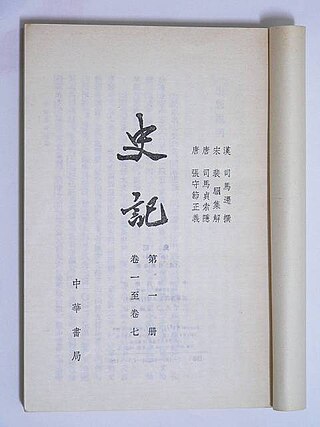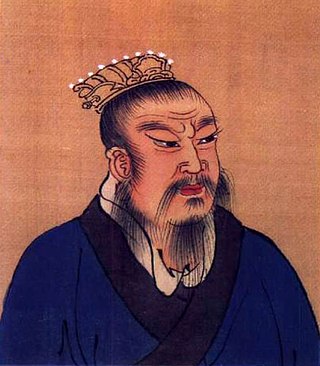Related Research Articles

Sima Qian ; c. 145 – c. 86 BC) was a Chinese historian during the early Han dynasty. He is considered the father of Chinese historiography for his Records of the Grand Historian, a general history of China covering more than two thousand years beginning from the rise of the legendary Yellow Emperor and the formation of the first Chinese polity to the reign of Emperor Wu of Han, during which Sima wrote. As the first universal history of the world as it was known to the ancient Chinese, the Records of the Grand Historian served as a model for official history-writing for subsequent Chinese dynasties and the Sinosphere in general until the 20th century.
The Xiongnu were a tribal confederation of nomadic peoples who, according to ancient Chinese sources, inhabited the eastern Eurasian Steppe from the 3rd century BC to the late 1st century AD. Modu Chanyu, the supreme leader after 209 BC, founded the Xiongnu Empire.

The Shiji, often known in English as Records of the Grand Historian or The Grand Scribe's Records, is a Chinese historical text that is the first of the Twenty-Four Histories of imperial China. It was written during the late 2nd and early 1st centuries BC by the Han dynasty historian Sima Qian, building upon work begun by his father Sima Tan. The work covers a 2,500-year period from the age of the legendary Yellow Emperor to the reign of Emperor Wu of Han in the author's own time, and describes the world as it was known to the Chinese of the Western Han dynasty.

Emperor Gaozu of Han, also known by his given name Liu Bang (劉邦), was the founder and first emperor of the Han dynasty, reigning from 202 to 195 BC. He is considered by traditional Chinese historiography to be one of the greatest emperors in history, credited with establishing the first Pax Sinica, one of China's longest golden ages.

Yu the Great or Yu the Engineer was a legendary king in ancient China who was credited with "the first successful state efforts at flood control", his establishment of the Xia dynasty, which inaugurated dynastic rule in China, and for his upright moral character. He figures prominently in the Chinese legend titled "Great Yu Controls the Waters". Yu and other sage-kings of ancient China were lauded for their virtues and morals by Confucius and other Chinese teachers. He is one of the few Chinese monarchs who is posthumously honored with the epithet "the Great".

Deng Ai, courtesy name Shizai, was a Chinese military general and politician of the state of Wei during the Three Kingdoms period of China. He is best known for his pivotal role in the Wei conquest of its rival state, Shu, in 263. He was described as a very loyal subject who made great contributions to Wei, but was also noted for his arrogance and audacity, which led to his downfall and death.

Zhong Hui, courtesy name Shiji, was a Chinese calligrapher, essayist, military general, and politician of the state of Cao Wei during the Three Kingdoms period of China. He was the younger son of Zhang Changpu with Zhong Yao, who served as the Grand Tutor in the Wei imperial court. He was already known for being insightful, intelligent and knowledgeable since he was young. Zhong Hui rose to prominence in the 250s when he became a close aide to Sima Zhao, the regent and de facto ruler of Wei. He advised Sima Zhao on how to deal with the Third Rebellion in Shouchun from 257 to 258 and was highly regarded by the latter. With Sima Zhao's help, Zhong Hui steadily moved up the ranks and became one of the key figures in the Wei government.
Liu Bao was a Southern Xiongnu leader who lived during the late Eastern Han dynasty and Three Kingdoms period of China. His son, Liu Yuan, founded the Han-Zhao dynasty during the Sixteen Kingdoms period.
Donghu was a tribal confederation of "Hu" (胡) nomadic people that was first recorded from the 7th century BCE and was taken over by the Xiongnu in 150 BCE. They lived in northern Hebei, southeastern Inner Mongolia and the western part of Liaoning, Jilin and Heilongjiang along the Yan Mountains and Greater Khingan Range.
Lu Wan was a Chinese military general, monarch, and politician who served as the vassal king of the early Han dynasty. He served under Liu Bang, the founding emperor of the Han dynasty.
Sima Tan was a Chinese astrologist, astronomer, and historian during the Western Han dynasty. His work Records of the Grand Historian was completed by his son Sima Qian, who is considered the founder of Chinese historiography.
Gun, also known as Count of Chong, is a figure in Chinese mythology, sometimes noted as the father of Yu the Great, the founder of the Xia dynasty. Gun was appointed to the task of controlling the Great Flood by Emperor Yao on the advice of the Four Mountains. Gun used dykes to try to stop the flooding but the dykes collapsed, killing many people.

Loufan County is a county of Shanxi Province, North China, it is under the administration of the prefecture-level city of Taiyuan, the capital of the province. It is the westernmost county-level division of Taiyuan.

The Xunyu is the name of an ancient nomadic tribe which invaded China during legendary times. They are traditionally identified with the Guifang, the Xianyun and the Xiongnu.

The Xianyun was an ancient nomadic tribe that invaded the Zhou dynasty. This Chinese exonym is written with xian獫 or 玁 "long-snouted dog", and this "dog" radical 犭 is commonly used in graphic pejorative characters. "Xianyun" was the preferred designation for northern tribes during the Zhou dynasty, earlier designations being the Xunyu, Guifang, and later ones being the Xiongnu, during the Han dynasty.

Guifang was an ancient ethnonym for a northern people that fought against the Shang dynasty. Chinese historical tradition used various names, at different periods, for northern tribes such as Guifang, Rong, Di, Xunyu, Xianyun, or Xiongnu peoples. This Chinese exonym combines gui and fang, a suffix referring to "non-Shang or enemy countries that existed in and beyond the borders of the Shang polity."

Hou Ji was a legendary Chinese culture hero credited with introducing millet to humanity during the time of the Xia dynasty. Millet was the original staple grain of northern China, prior to the introduction of wheat. His name translates as Lord of Millet and was a title granted to him by Emperor Shun, according to Records of the Grand Historian. Houji was credited with developing the philosophy of Agriculturalism and with service during the Great Flood in the reign of Yao; he was also claimed as an ancestor of the Ji clan that became the ruling family of the Zhou dynasty or a founder of the Zhou.
Lao Ai was an imposter eunuch and official of the State of Qin during the late Warring States period. Allegedly falsifying his castration in order to gain entry into the court of Qin, he became the favorite of Queen Dowager Zhao, the mother of Qin Shi Huang, later the First Emperor of China. He was enfeoffed as Marquis of Changxin (長信侯). After a conspiracy to incite rebellion was uncovered, he was executed by Qin Shi Huang.
Princess Jieyou, born Liu Jieyou, was a Chinese princess sent to marry the leader of the Wusun kingdom as part of the Western Han Chinese policy of heqin.
The Turkic creation myth is an ancient story about the creation of the Gaoche told among various Turkic peoples.
References
Citations
- 1 2 Sima Qian et al., "Records of the Grand Historian", "Ch. 110: Accounts of the Xiongnu"
- ↑ Wei Zhao et al., "Book of Wu", p. 2849
- ↑ Lin Gan 林幹, "Xiongnu shiliao huibian 匈奴史料彙編", Vol. 1, p. 1, Beijing, Zhonghua Shuju, 1988
- ↑ Sima Zhen. Suoyin, chapter 24, quote: "韋昭漢曰匈奴葷粥其别名則淳維是其始祖蓋與獯粥是一也"
- ↑ Pei Yin, Shiji jijie, Vol. 110 quote: "晉灼曰堯時曰葷粥周曰獫狁秦曰匈奴"
- ↑ Sima Zhen. Suoyin, chapter 24, quote: "應劭風俗通曰殷時曰獯粥改曰匈奴"
- ↑ Goldin, Paul R. "Steppe Nomads as a Philosophical Problem in Classical China" in Mapping Mongolia: Situating Mongolia in the World from Geologic Time to the Present. Penn Museum International Research Conferences, vol. 2. Ed. Paula L.W. Sabloff. Philadelphia: University of Pennsylvania. 2011. p. 237
- ↑ Sima Zhen. Suoyin, chapter 24, quote: "又樂彥括地譜云夏桀無道湯放之鳴條三年而死其子獯粥妻桀之衆妾避居北野隨畜移徙中國謂之匈奴". Note: In ms. 產 Chăn is written as 彥 Yàn, which is abbreviated to 产 and serves as 產's phonetic component.
- ↑ Sima Zhen. Suoyin, chapter 24, quote: "張晏曰淳維以殷時奔北邉"
- ↑ Goldin (2010). p. 237, n. 22
- ↑ Shiji, "Annals of the Five Emperors"
- ↑ Goldin, Paul R. (2010) "Steppe Nomads as a Philosophical Problem in Classical China" in Mapping Mongolia: Situating Mongolia in the World from Geologic Time to the Present. Penn Museum International Research Conferences, vol. 2. Ed. Paula L.W. Sabloff. Philadelphia: University of Pennsylvania. 2011. p. 225-226
Sources
- Zhonghan Wang, Outlines of Ethnic Groups in China, Taiyuan, Shanxi Education Press, 2004, p. 133, ISBN 7-5440-2660-4